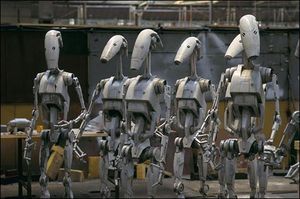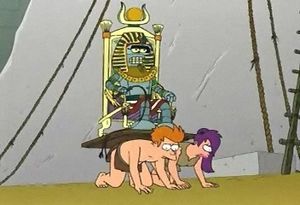Moose-Robot War of 1819
Much like the French and Indian War of colonial times, the Moose–Robot War of 1819 is a misnomer, and was actually a conflict in what is now Canada, between the British and native Moose, Robots, and Robot-Moose hybrids. After nine months of fighting, the Moose–Robot forces were forced to surrender and agree to turn their capital, Circuit City, into an electronic department store. The war solidified British control over North America, but also served as a prelude to the beginnings of Canadian independence a few decades later.
Prelude[edit | edit source]
As British settlements and fur-trading outposts expanded northward in the preceding centuries, the native Moose that inhabited the lands felt increasingly threatened. Likewise, with the opening of the Hudson Bay Copper Mining Company in 1815, the time-traveling robots from the future that had arrived in 1757 and peacefully settled what is now northern Quebec, felt pressure as they had to compete for the valuable metal that was necessary for replacement parts.
After the Moose king Rudolph III was duped into signing the so-called "Forest Frontier" pact in 1818, tensions mounted after the Moose realized that fine print in the treaty would force them to abandon the strategic town of Moosonee at the south end of Hudson Bay. Although the king, wanting to spare any bloodshed, agreed to retreat north, a few dozen renegade Moose refused to abandon the town and took up arms in defense. The British took the town by force at dawn on a frigid February 16th, 1819.
The head of the renegade Moose leader, Lockjaw, was placed as a trophy atop British Commander Cornwallis's mantle. The war had begun.
The Blitzkrieg[edit | edit source]
The British took advantage of the Moose's total lack of preparation for armed warfare, and initiated a quick drive north, taking over their settlements one by one. The Governor hoped the conflict would eliminate the Moose presence from the land once and for all, and was at the time famously quoted: "The only good Moose is a dead Moose." As broken antlers littered the battlefields, the Brits lost only a few dozen men over the first three weeks of conflict. The front quickly shifted nearly a hundred miles northward, at which point the bitter cold temperatures gave the advantage to the Moose, who by then were able to organize a more powerful defense. Historians generally agree that the blitzkrieg phase ended by March 12th, when the besieged town of Antlerton was able to successfully repel the British.
The Robots join the war[edit | edit source]

In the first phase of the war, the Robots remained neutral, but geared themselves for conflict and nervously observed the unfolding events. Their lands lay to the north-east of Moosonee, and there were no copper mines in that area, so they weren't directly affected by the "Forest Frontier" pact and the ensuing hostilities. However, matters quickly changes in mid-March, when British commanders, upset at the defeat at Antlerton, decided to encroach on Robot territory to cut off Moose supply lines.
The area directly east of the town was firmly under Robot control, but the Moose, who were at peace with the mechanical beings, used a road through the area as a quick resupply route from their barracks at Fort Hoofington. Under Lord Pompouston, the British decided to set up a blockade along the road and thus prevent Antlerton from getting resupplied.
On the morning of March 16 a Robot merchant caravan was passing through the area, and unable to distinguish the Robots through a thick fog that day, the soldiers at the blockade began shooting, thinking it was Moose resupply convoy. Only after all the unarmed Robot traders were all massacred did the British commanders realize what had happened. They quickly retreated into their own territory, later claiming it must have been the Moose who killed the merchants, but the Robots' advanced forensic technology was easily able to pinpoint the real culprits. The enraged Chief Automaton mobilized his forces and declared full-scale war against the British, simultaneously allying himself with the Moose kingdom.
Robot forces quickly sprung into action, and a contingent of one hundred swiftly routed the Brits from the vicinity of Antlerton. Many panicked soldiers abandoned their posts at the mere sight of their imposing metal enemies. The embarrassed Commander Cornwallis was forced to resign, and the British negotiated a brief cease fire at the end of the month; as a concession, they returned Lockjaw's head to the Moose for a proper burial, which took place at his home town of Furelton, where a memorial to the war's dead is currently located.
The stalemate[edit | edit source]
After the cease-fire ended, both sides of the conflict were slow to resume massive maneuvers. Each was afraid to encroach too far into the other's territory, and commanders were trying to size up their enemies. The stalemate lasted for months, with the only significant battle taking place at the British Fort Teatime, where a joint Moose–Robot battalion overwhelmed the unsuspecting British regimen on a hot day in late July. In a rare sign of primal emotions, the victorious Moose drank the blood of their dead enemies mockingly yelling "It's tea time!" Strategically though, the battle did little to improve either side's overall standing in the war.
The Battle of Copper Creek[edit | edit source]
With the stalemate dragging on for so long, British war planners decided for a risky tactic that ultimately paid off. With approval from the king himself, Commander Pompouston amassed all his troops into one giant platoon, leaving most of the front undefended. The meticulously planned maneuver was executed with great secrecy, and neither the Robots nor the Moose realized what had happened until it was too late. Then, on what is often referred to as "the D‑Day of the Moose–Robot War", August 28th, 1819, the British juggernaut struck at the heart of the Robots' military-industrial complex: the mining outposts of Copper Creek. The Robot defenders were caught completely by surprise, having been lulled into a false sense of security by the months-long stalemate. Moose reinforcements were dispatched to the area quickly, but they had far to travel as many Moose soldiers were on leave to celebrate St. Bovinus day later in the week.
Within a few short days, all the mining outposts along the creek were overrun, and the Robot in charge, Transistron, was forced to make a chaotic retreat with just a few dozen other surviving Robots. The battle was an enormous success for the British, who despite suffering many casualties knew that Robot production would be crippled and they would have to scrounge for replacement parts.
Chief Automaton knew the situation had suddenly turned dire, and he had troops retreat inland to consolidate defenses around the capital, Circuit City. A number of Moose were also relocated there at this time to shore up the city's contingent. The alliance prepared for the worst.
Doctor Elektron's breakthrough[edit | edit source]
With the defeat at Copper Creek, 80% of the Robots' copper production was lost. As casualties mounted the machines were desperate for replacement parts. The war would have likely been over by September (rumors have it Chief Automaton was barely prevented by his Robot wife from surrendering on the 17th), but a scientific breakthrough by leading scientist Doctor Elektron gave the alliance new hope.
After years of research, the Doctor was able to achieve something amazing - using Moose body parts as replacements for the Robots in lieu of copper. So now, for each Moose & Robot pair the British killed, the scientists were able to manufacture a new Robot–Moose hybrid that could be sent right back to battle. The only downside was that these new creatures had abnormally low intelligence, so their only use in battle was mainly as cannon fodder. With reinforcements from Europe, the British suffered many casualties over the ensuing month, but were able to withstand wave after wave of the hybrids, even making a slow but clear advance towards the heart of enemy territory. The war was nearing an end.
The peace treaty[edit | edit source]
By early November, British forces were within just miles of the Robot Capital, Circuit City. With the Moose population nearly halved by the war, and the Robots in shambles, defeat was inevitable. On the night of November 10th, Rudolph III and Chief Automaton conferred privately the Voltaic Palace, agreeing that it was in the best interest of their subjects to surrender. They sent messengers to the British Commanders, who got word of the surrender only hours before a siege of the outlying town Electropolis was about to commence. The Robots were forced to immediately surrender that town, at which time hostilities ceased. Rudolph III and Chief Automaton personally arrived in Electropolis to sign the peace treaty. On November 11th, 1819, the bitter war that cost tens of thousands of human, Moose, and Robot lives, was finally over.
The aftermath[edit | edit source]
The terms of surrender were harsh. The Moose and the Robots were forced to relinquish all territorial rights in North America. The Moose were banished north, to what are now the Northwestern Territories in Canada. In the 20th century, the remaining descendants of the once might Moose kingdom were given semi-autonomy in designated territories, much like native Americans in the United States. The Robots' fate was even worse following the peace treaty. Effective immediately, their capital was converted to an electronic department store, which still exists to this day under the name of Circuit City. The Robots themselves were herder to Newfoundland, and essentially kept as prisoners, until the British finally located their time travel portal in 1826. That year, all the surviving machines were forced into the portal, and into the future. Nobody knew what year the Robots were sent to, but it has since become clear that the Robots we've seen appearing since the 1960s are the very ones from the 19th century. Many fear that once enough of the Robots reappear, they will attempt to unite and reconquer the land we now know as Canada.




